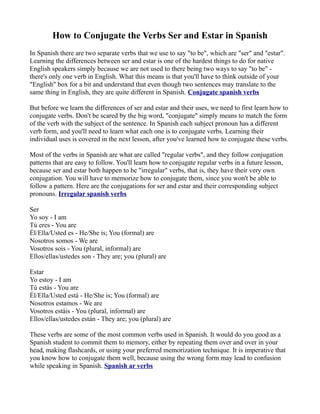How to Conjugate the Verbs Ser and Estar in Spanish
In Spanish there are two separate verbs that we use to say "to be", which are "ser" and "estar". Learning the differences between ser and estar is one of the hardest things to do for native English speakers simply because we are not used to there being two ways to say "to be" - there's only one verb in English. What this means is that you'll have to think outside of your "English" box for a bit and understand that even though two sentences may translate to the same thing in English, they are quite different in Spanish. But before we learn the differences of ser and estar and their uses, we need to first learn how to conjugate verbs. Don't be scared by the big word, "conjugate" simply means to match the form of the verb with the subject of the sentence. In Spanish each subject pronoun has a different verb form, and you'll need to learn what each one is to conjugate verbs. Learning their individual uses is covered in the next lesson, after you've learned how to conjugate these verbs. Most of the verbs in Spanish are what are called "regular verbs", and they follow conjugation patterns that are easy to follow. You'll learn how to conjugate regular verbs in a future lesson, because ser and estar both happen to be "irregular" verbs, that is, they have their very own conjugation. You will have to memorize how to conjugate them, since you won't be able to follow a pattern. Here are the conjugations for ser and estar and their corresponding subject pronouns. Ser Yo soy - I am Tú eres - You are Él/Ella/Usted es - He/She is; You (formal) are Nosotros somos - We are Vosotros sois - You (plural, informal) are Ellos/ellas/ustedes son - They are; you (plural) are Estar Yo estoy - I am Tú estás - You are Él/Ella/Usted está - He/She is; You (formal) are Nosotros estamos - We are Vosotros estáis - You (plural, informal) are Ellos/ellas/ustedes están - They are; you (plural) are These verbs are some of the most common verbs used in Spanish. It would do you good as a Spanish student to commit them to memory, either by repeating them over and over in your head, making flashcards, or using your preferred memorization technique. It is imperative that you know how to conjugate them well, because using the wrong form may lead to confusion while speaking in Spanish.

Recommended
More Related Content
Viewers also liked
Viewers also liked (20)
Recently uploaded
Recently uploaded (20)
How to Conjugate the Verbs Ser and Estar in Spanish
- 1. How to Conjugate the Verbs Ser and Estar in Spanish In Spanish there are two separate verbs that we use to say "to be", which are "ser" and "estar". Learning the differences between ser and estar is one of the hardest things to do for native English speakers simply because we are not used to there being two ways to say "to be" - there's only one verb in English. What this means is that you'll have to think outside of your "English" box for a bit and understand that even though two sentences may translate to the same thing in English, they are quite different in Spanish. Conjugate spanish verbs But before we learn the differences of ser and estar and their uses, we need to first learn how to conjugate verbs. Don't be scared by the big word, "conjugate" simply means to match the form of the verb with the subject of the sentence. In Spanish each subject pronoun has a different verb form, and you'll need to learn what each one is to conjugate verbs. Learning their individual uses is covered in the next lesson, after you've learned how to conjugate these verbs. Most of the verbs in Spanish are what are called "regular verbs", and they follow conjugation patterns that are easy to follow. You'll learn how to conjugate regular verbs in a future lesson, because ser and estar both happen to be "irregular" verbs, that is, they have their very own conjugation. You will have to memorize how to conjugate them, since you won't be able to follow a pattern. Here are the conjugations for ser and estar and their corresponding subject pronouns. Irregular spanish verbs Ser Yo soy - I am Tú eres - You are Él/Ella/Usted es - He/She is; You (formal) are Nosotros somos - We are Vosotros sois - You (plural, informal) are Ellos/ellas/ustedes son - They are; you (plural) are Estar Yo estoy - I am Tú estás - You are Él/Ella/Usted está - He/She is; You (formal) are Nosotros estamos - We are Vosotros estáis - You (plural, informal) are Ellos/ellas/ustedes están - They are; you (plural) are These verbs are some of the most common verbs used in Spanish. It would do you good as a Spanish student to commit them to memory, either by repeating them over and over in your head, making flashcards, or using your preferred memorization technique. It is imperative that you know how to conjugate them well, because using the wrong form may lead to confusion while speaking in Spanish. Spanish ar verbs